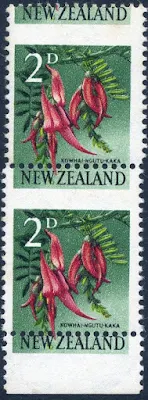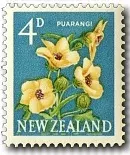A summary and overview of this issue with the stamps arranged issued order.
1960 - 1966 Pictorials Part Two.
This second part shows each of the stamps again but now arranged by their value.
1960 - 1966 Pictorials Part Three.
This second part shows each of the stamps again but now arranged by their value.
1960 - 1966 Pictorials Part Three.
Flaws and errors of the 1960 definitive - low values.
1960 - 1966 Pictorials Part Four.
Flaws and errors of the 1960 definitive - high values.
1960 - 1966 Pictorials Part Four.
Flaws and errors of the 1960 definitive - high values.
Postal history items.
 Flaws and errors were very common in this issue and in our drop box library we have around 114 images. Some are double ups and others very poor quality so I'm unsure how many will eventually make it into the blog.
Flaws and errors were very common in this issue and in our drop box library we have around 114 images. Some are double ups and others very poor quality so I'm unsure how many will eventually make it into the blog. Images of errors and flaws come from a variety of sources, often of different resolutions, so image size becomes a problem. Colour quality and accuracy is also a problem from some image sources too. We also tended to enlarge these stamps for greater clarity and detail of the errors. This often makes for an untidy looking page but we hope this will be overlooked in the interest of viewing some amazing stamps.
This post will only show errors/flaws in the lower values, native flowers from ½d - Manuka up to the higher 8d - Rata. Errors/flaws for the larger values are on a separate post.
½d - Manuka. (Normal Example.)
Left-hand stamp - 1960 ½d Pictorial with a flaw on 'M' of Manuka.
Right-hand block - ½d 1960 Pictorials double error, green & blue majorly shifted, which doubles design in many places.
This is a booklet featuring NAC the national domestic airline which eventually became part of Air New Zealand.
In this example 1960 ½d shows a green colour shift downwards.
1d - Karaka (Normal Example)
1960 Pictorials 1d Karaka a selvage vertical strip of 4, with missing yellow on top 2 stamps.
There also appears to be an image colour problem with this strip.
There also appears to be an image colour problem with this strip.
1960 Pictorials booklet with a major orange colour shift on the 1d Pane.
1960 Pictorials 1d booklet pane of 6 unhinged mint, double flaws, major orange Berries shift, red Stalk shift also.
2d - Kowhai-ngutu-kaka / Kaka Beak.
(Normal Example).
The 1960 New ZF Error. It is a bit hard to see the 'E' looks more like a 'F'
because of the black line of the postal cancelation.
Left-hand Pair - 1960 Pictorial 2d vertical pair with green base colour omitted in 40% of top stamp, frame omitted both stamps, cracked plate lower stamp.
Middle Pair - 960 Pictorial 2d, mint pair with striking Dr Blade flaw in black, 1 inch long approx.
Right Pair -1960 Pictorials 2d Kaka with huge perforation shift.
1960 Pictorials 2d Kowhai Flower, part imperf. Notice how the stamps have been torn when separated.
2½d - Titoki (Normal Example)
Left-hand Stamp - Major upward shift of the yellow until now it over prints the value.
Right-hand Stamp - Smaller shift of the black, best seen in the doubling of the value.
Left-hand Block - 1960 2½d Titoki - Green omitted from lower stamps in this block.
Right-hand Block - 1960 2½d Titoki - Yellow is omitted from this block.
3d - Kowhai (Normal Example).
Blue Colour separation being passed-off as an error.
This block was offered for sale as a 1960 Pictorails 3d Kowhai missing yellow, brown & green, 3 missing colours, printed only in blue. Blocks like this usually appear as a single colour separation which they are, but what confused me in this case is that the block had been perforated. Now PW clears this mystery up in his comment below. This is one of a set of four colour separations prepared by the printers De La Rue.
When I saw 3 or 4 blocks like this on a single web site it is obvious they managed to get hold of most of a full sheet and have been breaking it into smaller lots for sale. This shows the danger for inexperienced collectors thinking they are buying something special.
Left-hand Pair - Green is omitted from the bottom stamp.
Middle Pair - Yellow is omitted from the top stamp.
Right-hand Pair - Brown is omitted from the top stamp and partly from the bottom stamp.
Left-hand Block - There is a water mark across the centre pair.
Right-hand Stamp - A white Doctor Blade marks runs down through the right column.
Yellow Doctor Blade mark in right selvage.
4d - Puarangi (Normal Example).
This block of 8 stamps has a fine light green colour shift, Branches are now white, Flowers have taken on a green ghost. The blue seems the wrong colour too so I'm wondering if we are also looking at an image quality problem as well. Nice plate block.
In this strip of 3 the buff has been completely omitted.
5d - Matua Tikumu / Mountain Daisy
Issued 1962. (Normal Example).
1960 Pictorials 5d Flower, with a large yellow colour shift on angle 1mm to left up & down.
Left-hand Block - A major shift in the black. You can see it best near the top left side of the flowers/leaves.
Right-hand Block - A major shift in the yellow. Almost move right off the flower.
Left-hand Stamp - A black Doctor Blade flaw across the top of the stamp.
Right-hand Stamp - Yellow has been completely omitted.
Now here is a good one. There was a tooth missing on the perforation comb.
6d - Pikiarero / Clematis. (Normal Example.)
1960 Pictorials 6d Clements, Left-hand selvage block of 4 with olive colour omitted & lilac colour majorly shifted down
7d - Koromiko (Issued 1966)
(Normal Example)
7d Koromiko Flower, block of four with multiple colour shifts, red to right, yellow to left & back ground colour downwards which makes it very difficult to establish just what is going on.
8d - Rata. (Normal Example).
1960 Pictorials 8d Rata, seldom seen error on this stamp, major red colour shift upwards.
Some of the images in this post were used with permission from the illustrated catalogue of StampsNZ
You can visit their web site and On-line Catalogue at, http://stampsnz.com/











































I agree with you Mary about that block of 3d stamps. When I see a large block of only one colour I begin to think, 'Has this been stolen from the printer's factory?' In which case it's rather like a fake.
ReplyDeleteCS
While we agree on the unusual past of this block I still consider it to be of interest so its been included here.
DeleteMary
ReplyDeleteI have just come across this site and have found it very interesting.
I collect New Zealand Stamps and have collected the 1960 issue since I was a schoolboy.
The 3d with "three missing colours" is no such thing. It is one of a series of 'colour separations' produced by De La Rue just prior to printing the 3d value for issue in 1960. One sheet of each separation exists (similar for the 2d value). A dealer in New Zealand put these on the market around 20 years ago but you don't see many of them around (I have a full set of blocks) which makes you wonder where they have disappeared to. The other colour separations of the 3d are so obviously proof material (badly misplaced as well) but the blue-green separation is very dangerous and is being passed off by dealers as "three colours omitted". The colour is very different from the issued stamp being a very cold, almost greyish blue-green. There was an article on the subject in 'The Kiwi', journal of The New Zealand Society of Great Britain, September 2013
PW
Thank you PW
DeleteAs I said above I was wondering about that block. What confused me was the fact that while it was only a single colour, it had been perforated. You clear up the mystery nicely. Thanks for that.
I'm going to leave the block on this page but will change my caption under it. I'll also direct readers to you comment here.
Do you know where we can find a photograph of a First Day Cover for the original issue of this set?
Mary
Hey Mary, I know this is quiet an old post but I was wondering if youd be interested in seeing some flaws ive found for the 1960 Kaka Beak. I found yellow colour shifts and red colour shifts that are quiet bad :)
ReplyDeleteYes we would love to see them. Always interested in something new.
DeleteMary
We appreciate your engagement with our content. To ensure a respectful and constructive community, please take note of the following:
- No Spam, Please: We do not tolerate spammy or promotional comments. Any such comments will be promptly removed.
- Moderation in Place: All comments are moderated to maintain a positive and inclusive environment. Please be patient, as it may take a little time for your comment to appear.
- Sign In with Google: To comment, please sign in using your Google account. This helps us maintain the integrity of our community and allows for better interaction.